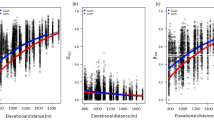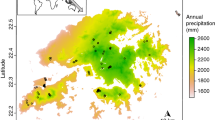Abstract
Species coexistence can reflect niche partitioning at several spatial and temporal scales. We measured patterns of spatial and temporal niche overlap in an Oklahoma grassland ant assemblage. Ant species foraging on a 400-m2 grid of 25 tuna-fish baits were censused hourly for one 24-h period each month for 1 year. We used partial correlations to analyze pairwise associations of the four commonest species, and a null model analysis to quantify niche overlap among all seven species present. On a seasonal (monthly) time scale, niche overlap and pairwise species associations were random or aggregated, probably due to thermal constraints on ectotherms foraging in a seasonal environment. Within the warmer months of the year, there was some evidence of diurnal (24 h) niche partitioning: the variance in niche overlap was often greater than expected, and common species displayed both negative and positive associations with each other and with ambient air temperature. The strongest evidence for niche partitioning was at the spatial scale of individual baits. Species occurrences at baits were dynamic, with considerable turnover in composition and significantly less spatial niche overlap than expected by chance. These results are consistent with other studies suggesting that ant species partition resources at fine spatial and temporal scales.
Similar content being viewed by others
Author information
Authors and Affiliations
Additional information
Electronic Publication
Rights and permissions
About this article
Cite this article
Albrecht, M., Gotelli, N. Spatial and temporal niche partitioning in grassland ants. Oecologia 126, 134–141 (2001). https://doi.org/10.1007/s004420000494
Received:
Accepted:
Published:
Issue Date:
DOI: https://doi.org/10.1007/s004420000494




